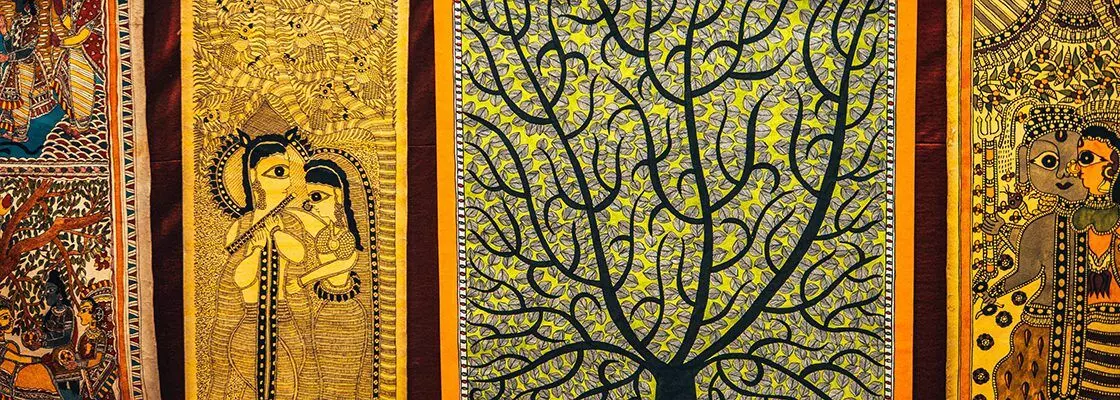Preservation through digitisation
A digital repository for folk paintings can go a long way in preserving, protecting, and promoting India’s fast-fading rich heritage of folk art

As an aficionado of Indian art, I often grapple with a perplexing question; how many folk paintings does India – the land of diverse traditions — truly possess?
Folk paintings are an integral part of India's rich cultural heritage, and many of these art forms have been passed down through generations orally. It was heartening to see the display of Jal Sanjhi at the G20 Sherpa meeting, garnering the attention and appreciation it deserves. However, this display also serves as a reminder that several other folk paintings and art forms are slipping into oblivion, losing their fight against time and modernisation. These art forms, once cherished and celebrated by the people of their respective regions, are now on the verge of extinction. Thus, it is important to acknowledge the continuities and evolution of Indian folk arts.
Documentation helps in preserving art forms and their associated cultural knowledge for future generations. It provides artists with a platform to showcase their work to a wider audience, garnering attention on both the international and domestic fronts, and providing economic opportunities. Youth today are oblivious to the country's rich and diverse cultural legacy. The need for openness and understanding among people has become paramount.
It is difficult to determine the exact number of folk paintings in India, as various regional styles and forms of folk art are practised across the country. Each state and region in India has its own unique style of folk painting, which often reflects the local culture, tradition, and mythology. Some of the popular forms of folk painting in India include Madhubani from Bihar, Warli from Maharashtra, Pattachitra from Odisha, Gond from Madhya Pradesh, and many more.
It is crucial that a national platform be established to document folk paintings in collaboration with the practising communities, with a well-organised system for research and publication.
Digitisation has proven to be an effective tool in preserving, disseminating, and sharing cultural material across the globe. India has set an example for protecting its traditional knowledge through the institutional framework of the Traditional Knowledge Digital Library (TKDL). TKDL has been successful in fusing traditional knowledge and technology, boasting a database of over 4 lakh formulations from various traditional knowledge systems. Similarly, developing a digital repository for folk paintings would be a significant step towards preserving, protecting, and promoting the rich heritage of Indian folk art. TKDL's expertise in digitisation can be leveraged to document and categorise various folk paintings based on parameters such as region, painting style, medium, and occasion. The digitised images of the paintings can be stored in a database, along with relevant information about the history and technique of the art form. This will facilitate easy access for researchers and enthusiasts to find and learn about the paintings, thereby promoting the preservation and promotion of Indian folk art.
India can leverage its G20 presidency to facilitate collaborations and knowledge sharing among the member countries to document and preserve folk paintings. Creating a forum for member nations to discuss their experiences, achievements, and difficulties in maintaining traditional art forms can be helpful.
G20 nations like South Korea, South Africa, Turkey, and Canada have carefully crafted national strategies that can provide insights into implementing policy and tackling shared problems.
South Korea has been actively engaged in promoting and preserving its traditional knowledge through a range of initiatives. The country has set up a cultural and art exchange platform for developing countries as part of its cultural ODA projects, which includes programmes like the Cultural Partnership Initiative that offers training and joint production programmes for artists from developing countries in Asia, and The Dream Project that provides intensive art education courses in Korea for artistically talented individuals from developing nations.
Additionally, South Korea has undertaken projects like the Thank You Small Library project which aims to open libraries in African countries to support educational and cultural infrastructure in developing nations. The country has also implemented cultural property protection projects that transfer conservation and restoration technologies to developing countries.
India can also use its presidency to push for the inclusion of traditional art forms, such as folk paintings, in curricula and programmes for cross-cultural interaction. By doing this, India can encourage the next generation to value and appreciate the cultural diversity and abundance of traditional art forms.
The future of Indian folk arts is dependent on the level of support it receives from both the government and the public. It is important to recognise that art is not just the final product, but rather the narratives, dedication, time and skills that are woven into it. It is imperative that efforts are made to provide a platform for these arts to thrive, whether it be through the establishment of creative hubs, the use of technology to connect rural artists with larger audiences, or increased collaboration with younger generations. By doing so, we can not only preserve these traditions but also promote them to the wider world, providing a much-needed boost to both rural tourism and the rich cultural fabric of India as a whole.
The writer is Young Professional, EAC-PM. Views expressed are personal



